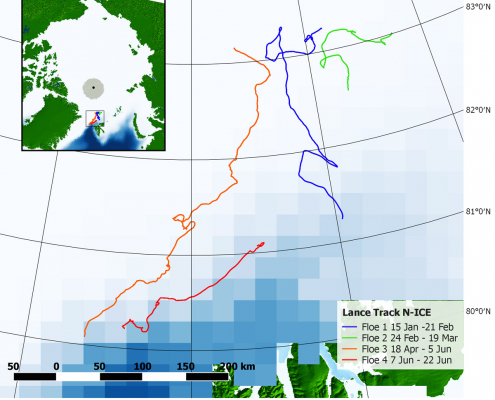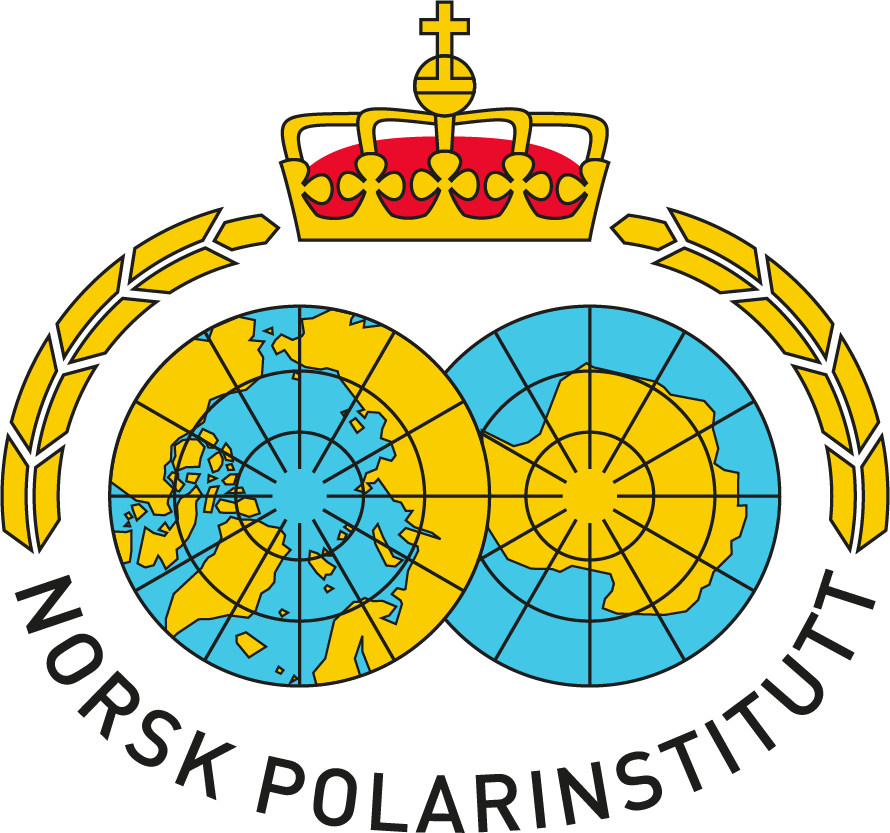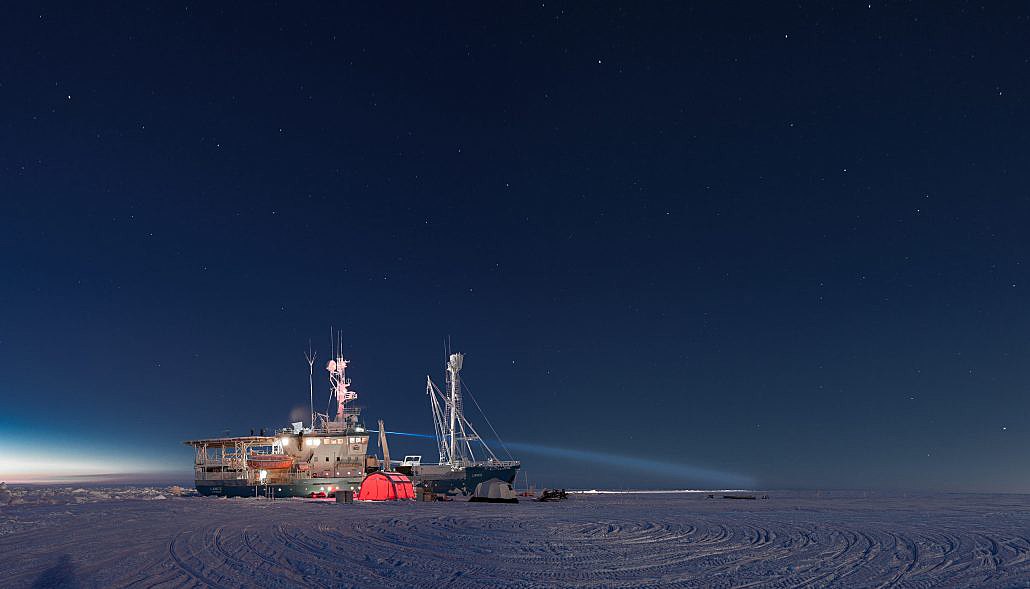The objective of N-ICE2015 is to understand how the rapid shift to a younger and thinner sea ice regime in the Arctic affects energy fluxes, sea ice dynamics and the ice-associated ecosystem, as well as local and global climate.
Many of the results from the experiment are published in a dedicated special issue in the Journal of Geophysical Research: Oceans, Journal of Geophysical Research: Atmospheres and Journal of Geophysical Research: Biogeosciences.
- Area:
- Type:
- Topic:
- Leaders:

Publications
Data sets
Background
The past decades have seen rapid change in the Arctic sea ice pack. The ice has become thinner and younger, and the older multi-year ice has been largely replaced by ice that is younger than 2 years old. These changes in the characteristics of the ice could suggests that the entire sea ice system is now functioning differently than before. This poses a fundamental question: Is the knowledge we have from only a decade ago still valid?
In order to predict the future of the Arctic sea ice, and its effects on the climate, ocean and ecosystems, we need good knowledge of the state of the system today, and an understanding of the governing processes of today and tomorrow. However, there’s a gap in our current knowledge: The Arctic sea ice has changed rapidly and dramatically in recent years, while at the same time our understanding is still based largely on observations made during an earlier regime, when thicker and older ice dominated the icescape in the Arctic Ocean.
The N-ICE2015 field campaign aims to address this knowledge gap, by contributing unique and needed direct observations to the global scientific community. Thus, the project is ultimately improving our capacity to model the future.
Main objectives
- What melts the ice? Warm Atlantic water or solar heat?
- How does the thinner ice respond to atmospheric forcing, such as storms?
- How does thinner ice affect ice dynamics, and how can we improve ice drift models?
- What are the effects of the changed sea ice system on the ice-associated ecosystem?
- What are the effects on local and global weather systems?
- Contribute to improved computer models to predict future conditions more accurately.
Highlights of preliminary findings
- The ice pack had already accumulated nearly 0.5m of snow in January. This is much more than we expected based on climatology.
- The thick snow cover slowed sea ice growth. Ice formed mainly in leads. The thick heavy snow also contributed positively to the ice mass balance through snow-ice formation.
- Many storms took place, especially in winter. These brought with them warm and moist air, even in the middle of the polar night, also slowing ice growth.
- The storms also affected ocean mixing. Heat, nutrients, and CO2 were mixed throughout the upper water column during storms. We saw the ocean heat flux increased twofold during storms.
- The thinner sea ice was more easily broken up and we saw more ridging and lead formation than previously .
- Leads caused by storms allowed enough light to reach the water, sufficient to initiate and maintain an algae bloom under thick snow-covered ice that otherwise would have kept the algae community in the dark and unable to grow.
- The heavy snow load resulted in seawater infiltration at the snow–ice interface. This provided a habitat that supported ample algae growth, resembling conditions in the Antarctic sea ice zone.
The expedition

DRIFT PATHS: The 4 drifts undertaken during N-ICE2015 field campaign. The legend gives the start and finish dates for the each of the drifts. The northern tip of Spitsbergen is visible in the bottom. The pale white background is the ice concentration in May 2015 from NSIDC. Map: Mats Granskog / Norwegian Polar Institute
The expedition was carried out by taking the Norwegian Polar Institute’s research vessel Lance to 83°N 21°E and let her drift with the ice, with the ship as a research base for the personnel and the ice floes surrounding it functioned as a research camp.
Conditions were challenging. The ice drifted faster than expected, and was also very dynamic. As we approached the ice edge, the rapid ice drift and dynamic conditions caused the ice floes carrying the research camp to break up, and we had to evacuate the camp. This happened on four occasions, and every time we had to re-establish the drifting research camp (see map).
The ice pack consisted mainly of first- and second-year sea ice, with a thickness of around 1.3–1.5 m. This is representative of a thinner ice pack than what has been studied earlier in the Arctic. As such, we met the conditions for studying a thinner Arctic sea ice pack, the new Arctic
.
Expedition facts
Dates: 12 January – 24 June 2015
Distance covered: 4007 nautical miles (whole expedition)
Operation time: 111 days attached to an ice floe, and with the research camp running
Personnel: 69 researchers, 27 engineers / support crew
Norwegian collaborations:
- UiT The Arctic University of Norway
- University of Bergen (UiB)
- Norwegian Meteorological Institute (MET Norway)
- Norwegian University of Science and Technology (NTNU)
- The University Centre in Svalbard (UNIS)
International collaborations:
- Alfred Wegener Institute (AWI), Germany
- British Antarctic Survey (BAS)
- Cold Regions Research Engineering Laboratory (CRREL), USA
- Danish Meteorological Institute
- Finnish Meteorological Institute (FMI)
- Finnish Environmental Institute (SYKE)
- Korea Polar Research Institute (KOPRI)
- Arctic and Antarctic Research Institute (AARI) , Russia
- Colorado State University, USA
- Hokkaido University, Japan
- Washington State University, USA
- University of Manitoba, Canada
- Technical University of Denmark
- University Pierre and Marie Curie, France
Overflights
- 2 overflights by the Ice, Climate, Economics – Arctic Research on Change (ICE-ARC), an EU Seventh Framework Programme (EU FP7), British Antarctic Survey (BAS), Technical University of Denmark (DTU), and European Space Agency (ESA) collaboration.
- 1 overflight by NASA’s Operation IceBridge
Outreach
- National Geographic
- BBC
- Norwegian Broadcasting Corporation (NRK)
- “Mission Arctic” series
- News articles
- Talk at the 2015 UN Climate Change Conference (COP21)
- Social media, hashtag #NICE2015Arctic
Learn more
- The Conversation: Winter storms are speeding up the loss of Arctic sea ice
- The Conversation: The freak warm Arctic weather is unusual, but getting less so
- EOS: Arctic Research on Thin Ice: Consequences of Arctic Sea Ice Loss
- EOS: Exploring a More Dynamic Arctic Icescape
- BBC: Announcement movie
- BBC: Crossing a track
- BBC: Tour of the ship
- BBC: How scientists research sea ice
- BBC: Arctic research from an ice bound boat
- BBC: Arctic temperature rising
- National Geographic:
Drifting With the Ice
(VIDEO, 2 min) - National Geographic: Arctic Ship Breaks Free of Ice for Historic Expedition
- National Geographic: ‘This Is Really Extreme Science’: Adrift in the Arctic Ice With a Shipload of Norwegians
- National Geographic: Storm Rocks Arctic Research Ship Like ‘Titanic Bulldozer’
- National Geographic: Facing Polar Bears, Isolation, Researchers Explore Arctic Sea Ice
- Nature: Incredibly thin Arctic sea ice shocks researchers
- Scientists see ‘new Arctic’ is more prone to melting and storms
- AGU FM16 Press Conference: First results from the Norwegian Young Sea ICE Expedition (VIDEO, 30 min)
- Discover Magazine: Why did scientists deliberately freeze themselves into sea ice near the North Pole, enduring storms and brutal cold?
- bioGraphic: On Thin Ice

